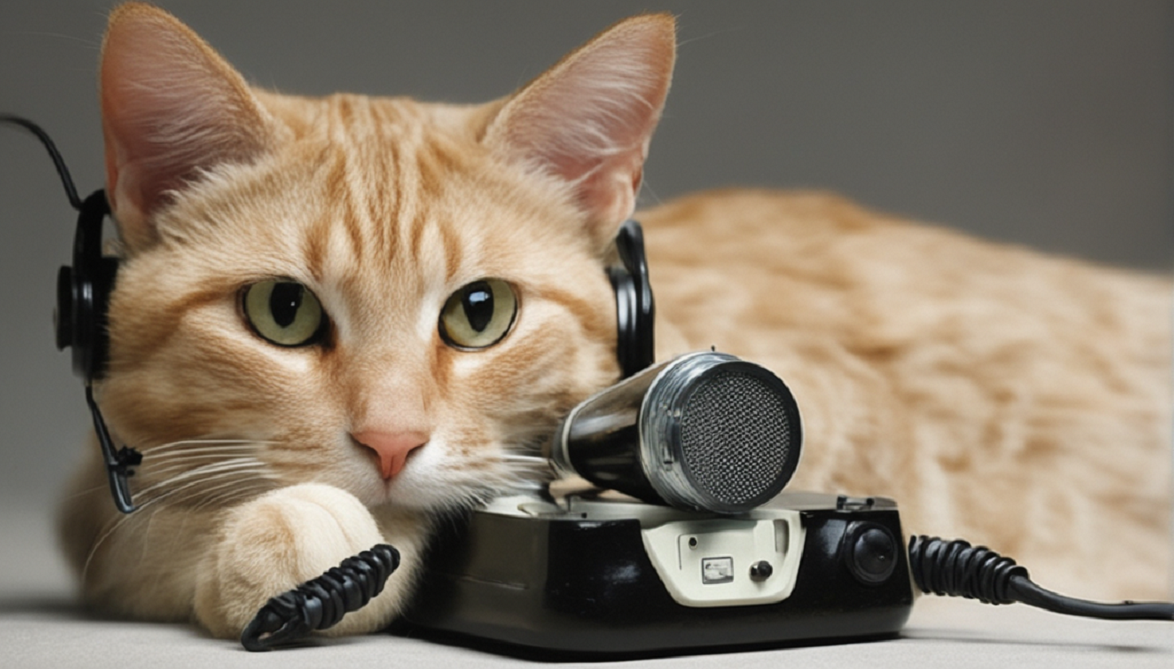The world of espionage has always been filled with fascinating and often shocking tales of covert operations. From the likes of James Bond to real-life spies, the cloak-and-dagger world has captivated the imaginations of people for decades. Among these incredible stories lies a peculiar yet remarkable chapter in the history of the Central Intelligence Agency (CIA) – the Acoustic Kitty program. In this article we delve into the astonishing story of Acoustic Kitty, a daring and technologically ambitious attempt by the CIA to transform ordinary cats into espionage assets.
The Origins of Acoustic Kitty
The Cold War era, characterized by the intense rivalry between the United States and the Soviet Union, spawned an atmosphere of innovation in the realm of intelligence gathering. Amidst this backdrop, the CIA sought to exploit the remarkable abilities of cats to develop an unprecedented espionage tool. The beginning of Acoustic Kitty lay in a joining of technological advancements, studies in animal behavior, and the insatiable quest for unconventional means of surveillance.
In the early 1960s, a confluence of factors led the CIA to consider cats as potential agents. Studies in animal behavior have revealed that cats possess a unique blend of agility, discretion, and curiosity – traits that could potentially make them adept at infiltrating sensitive areas without arousing suspicion. This revelation spurred the birth of a groundbreaking idea: to train cats as living surveillance platforms.
A dedicated team of experts from various disciplines was assembled to bring this ambitious concept to fruition. Animal behaviorists, veterinarians, and engineers collaborated to chart the course for transforming ordinary cats into spying operatives. The project’s foundation rested on understanding feline psychology and behavior, an essential step in training cats to follow specific instructions and carry out covert operations effectively.
Ethical considerations and practical challenges were not ignored. The CIA faced the task of reconciling the innate behavior of cats with the demands of espionage. Could cats be conditioned to act against their natural instincts? How could the agency ensure the safety and well-being of the animals involved? These questions underscored the complexity of the endeavor and the need for a meticulous approach.
Training the Spy Cats
The transformation of cats into covert operatives required an intricate balance between animal behavior expertise, cutting-edge training methodologies, and an unwavering dedication from the CIA’s team of specialists.
The process of converting cats into effective spies began with fundamental obedience training. Accomplished animal behaviorists and trainers honed the cats’ responsiveness to commands, fostering the ability to execute tasks under various circumstances. Unlike typical training, which might involve treats as rewards, the Acoustic Kitty program focused on shaping behaviors through positive reinforcement, forging associations between desired actions and favorable outcomes.
However, obedience training was only the tip of the iceberg. The program dug into more complex aspects, including conditioning cats to remain calm under stress, ignore distractions, and operate seamlessly within unfamiliar environments. These traits were pivotal for covert operations, where maintaining composure and following directions were of paramount importance.
To prepare the cats for their technological roles, trainers introduced them to the specialized equipment that would be integrated into their bodies. Miniature microphones, antennae, and other listening devices were surgically implanted, necessitating a process of acclimatization. Trainers ensured that the cats adapted naturally to the implants, ensuring comfort and minimizing the potential for behavioral changes.
Simulated environments were constructed to mirror real-world scenarios, exposing the cats to a spectrum of sights and sounds they might encounter during missions. This immersive training aimed to develop the cats’ adaptability and poise under pressure, ensuring that their espionage tasks would be executed seamlessly, regardless of the challenges faced.
Physical and mental conditioning were integral components of the training regimen. Exercise routines were tailored to enhance the cats’ agility and stamina, essential attributes for successful infiltration and extraction missions. Mental exercises were incorporated to stimulate problem-solving skills, enhancing the cats’ decision-making capabilities and situational awareness.
Selection for actual missions was a rigorous process that assessed not only the cats’ skills but also their compatibility with the assigned tasks and environments. The culmination of training marked the transition from household pets to highly skilled operatives poised for espionage.
Technological Marvels: Outfitting the Feline Spies
Equipping living creatures with cutting-edge surveillance technology was a monumental challenge that the Acoustic Kitty program undertook with boldness and innovation.
The seamless fusion of biology and technology required meticulous planning and surgical precision. The integration of miniature microphones, antennae, and other listening devices into the cats demanded a delicate balance between functionality and the animals’ well-being. Veterinary expertise was vital to ensure that the implants were safe, non-intrusive, and did not cause discomfort or adverse reactions.
Surgical procedures involved implanting the devices within the cats’ bodies, strategically placing them to capture audio from the surroundings. This process was a testament to both medical expertise and technological ingenuity. The challenge was twofold: ensuring the devices were secure and functional, and minimizing the impact on the cats’ mobility and behavior.
The ethical implications of surgically modifying animals for spying were not overlooked. The CIA had to navigate complex questions about the welfare of the cats and the moral responsibility of using living creatures for covert operations. Balancing technological innovation with ethical considerations was a delicate tightrope walk that demanded careful introspection.
The cats’ innate abilities, coupled with the implanted technology, turned them into inconspicuous surveillance platforms capable of venturing into spaces that would be inaccessible or suspicious for human agents.
The First Mission
The culmination of years of preparation and training led to the launch of the Acoustic Kitty program’s first mission.
The inaugural mission tasked the cat operative with infiltrating a target location to gather intelligence. The cat’s agility, discretion, and heightened senses made it an ideal candidate for covert entry, and its integrated technology promised to provide an unparalleled vantage point for intelligence collection.
The challenges were manifold. Ensuring the cat followed directions without deviating from its mission was a test of both training and technology. The unpredictability of real-world scenarios, including interactions with unforeseen factors like human behavior and environmental variables, added an element of uncertainty to the operation.
The mission showcased both the potential and limitations of the Acoustic Kitty program. The cat successfully infiltrated the target location, and its implanted devices captured valuable audio data. However, the challenges of maintaining control and directing the cat’s movements in an uncontrolled environment also surfaced, underscoring the complexities of using living creatures for spying.
The Downfall of Acoustic Kitty
The Acoustic Kitty program’s remarkable journey was not without its setbacks. Technical glitches, behavioral challenges, and operational failures coalesced to bring the program to an unforeseen end.
The pivotal mission involved a high-stakes operation where the feline operative’s role was critical. However, unforeseen technical issues emerged, compromising the integrity of the surveillance devices. The cat’s behavior, which was meticulously conditioned during training, exhibited unexpected deviations under the pressures of a real-world operation.
The operational failure served as a stark reminder of the unpredictable nature of spying and the inherent risks of using living creatures for such tasks.
The culmination of this mission triggered a reevaluation of the program’s viability, prompting the CIA to question the practicality of employing animals as espionage assets.
Legacy and Ethical Implications
The end of the Acoustic Kitty program did not mark the end of its impact. The program’s termination spurred introspection within the intelligence community. The ethical dilemmas inherent in modifying animals for espionage missions ignited discussions about the ethical boundaries of intelligence work. The blending of technology and nature underscored the complex relationship between scientific advancement, national security, and animal welfare.
The Acoustic Kitty program’s legacy extended beyond its operational outcomes. The audacity of the endeavor left an indelible mark on the history of spying, serving as a testament to human ingenuity and the willingness to explore unconventional methods. It also sparked contemplation about the necessity of pushing the boundaries of innovation, even when faced with practical limitations and ethical concerns.
Beyond its immediate impact, the program’s legacy reverberated through subsequent intelligence efforts, prompting a more nuanced examination of the integration of animals and technology into espionage practices.
Aftermath and Speculations
While the Acoustic Kitty program may have concluded, its influence persisted. With the program’s discontinuation, questions arose about the fate of the feline operatives. Speculations and myths began to circulate, fueled by a mixture of curiosity and the human tendency to create narratives around the unknown. These myths often took on a life of their own, contributing to the mystique surrounding the program.
Conspiracy theories, ranging from cats secretly being deployed as spies to notions of advanced animal-human communication, emerged in the wake of the program’s exposure. These theories underscored the program’s lasting impact on popular culture and its enduring place in the collective imagination.
Final Thoughts
The tale of Acoustic Kitty digs into the depths of innovation and ambition, unveiling a shadowy world where intelligence agencies dared to breach the boundaries of ethics and practicality. It stands as a stark reminder of the extremes to which those in the pursuit of information can be driven, even at the cost of exploiting unsuspecting creatures.
Amidst the excitement of spying, the Acoustic Kitty program embodies a darker underbelly. It’s a testament to the dangerous dance between scientific curiosity and ethical considerations. The melding of biology and technology painted a picture of uncharted possibilities, but it also exposed the unsettling willingness to manipulate nature in the name of national security.
As we peer back into this incomprehensible chapter of history, we’re confronted with the unsettling legacy of Acoustic Kitty – a legacy that whispers about the moral quandaries that persist in the shadows of intelligence operations. The program’s audacity prompts us to reflect on the fine line between innovation and recklessness, and the enduring consequences of venturing into the murky waters where the ends may justify the means.
Acoustic Kitty remains not only a tale of whiskered intrigue, but also a haunting reminder that the pursuit of secrets can cast a long shadow over ethics and the sanctity of life.



